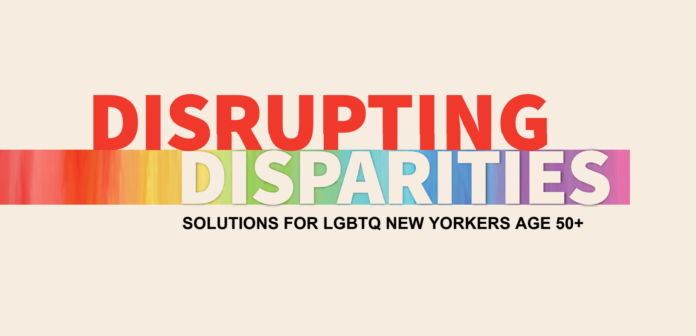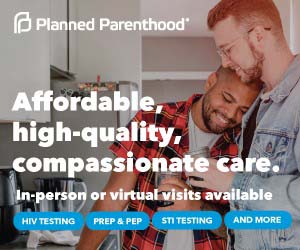In a first of its kind report, SAGE, which provides advocacy and services for LGBT+ elders, has released a report on the status of New Yorkers age 50+. The news is not good.
“Disrupting Disparities: Solutions for LGBTQ New Yorkers Age 50+,” was commissioned by AARP New York and SAGE with support from the AARP Foundation. SAGE notes that “50 years after the Stonewall riots ignited the modern LGBT equality movement, nearly a third of LGBT New Yorkers are over the age of 50, but the fight is far from finished.”
This first-of-its-kind report “includes an array of policy and legislative solutions that can serve as a roadmap for elected officials and policymakers at both the state and local levels of government,” SAGE said in a statement. Those answers include mandating a minimum level of LGBTQ cultural competency training for state-funded providers from organizations with expertise in LGBTQ aging.
The disparities facing LGBT+ elders are manifold and include problems accessing inclusive mental and physical health care, increased social isolation, maintaining economic security and finding adequate and affordable housing.
LGBTQ New Yorkers aged 50+ face steeper barriers to healthcare, higher rates of poverty, and greater challenges to their economic security than their non-LGBTQ counterparts. As other recent studies have shown, the COVID-19 crisis has only exacerbated these disparities, according to the data.
The most shocking data regards poverty among elders. One-third of LGBTQ people 50+ live at or below 200% of the federal poverty level, compared to a quarter of non-LGBTQ people. Twenty-one percent of LGBTQ people aged 50+ have provided care to friends: more than triple that of non-LGBTQ peers. And 23% of LGBTQ New Yorkers of all ages cite inadequate insurance coverage as the most significant barrier to healthcare.
“This is unacceptable,” said AARP New York State Director Beth Finkel. “We are calling on state lawmakers to address this right now. It’s even worse for LGTBQ people of color and transgender older people. And the pandemic has only exacerbated these disparities.”
SAGE explains that while nearly one-third of LGBTQ New Yorkers are 50+, the elder population — which is growing rapidly — remains largely invisible. These LGBTQ people face disparities stemming from decades of discrimination. That combines with a lack of legal and social recognition and reduced access to inclusive services. SAGE notes that “despite resilience, LGBTQ older people are still facing negative health, economic and social implications that demand action.”
“For decades, SAGE has seen the realities of this report first-hand. While we have certainly made progress since Stonewall, LGBTQ elders can’t afford to keep waiting for vital policies to protect their rights and promote their well-being,” said SAGE CEO Michael Adams. “We’re thrilled that SAGE’s partnership with AARP New York brings the full weight of the country’s most influential advocate for older Americans to the public policy table on behalf of LGBTQ elders.”
“In New York, LGBTQ adults 50 and older, especially those of color, face unique challenges as they age, leading to widespread disparities in their health, economic security, caregiving, housing, and social connections,” said Lisa Marsh Ryerson, President of AARP Foundation. “These challenges have worsened during the COVID-19 pandemic.”
Nii-Quartelai Quartey, AARP Senior Advisor & National LGBT Liaison led a conference in Pennsylvania on LGBTQ elders in 2019, as PGN reported. “The COVID-19 pandemic has laid bare the unconscionable health and financial disparities that are made more difficult by the racial identity, sexual orientation, and gender identity of older New Yorkers.”
Quartey asserted that the report goes further than New York LGBTQ people. They said, “The action steps taken by local, state, and federal leaders from New York have the potential to offer the nation examples to narrow some of the most persistent disparities based on the lived experience of LGBTQ older adults on the margins in our communities.”
It’s a disturbing list of issues that includes mental and physical health disparities due to the lack of competent, inclusive health care. These disparities include 41% of LGBTQ older people reporting having a disability. Poor physical and mental health, alcohol and tobacco use, HIV and cancer all put LGBTQ older people at risk of experiencing COVID-19 more acutely.
One study found about 40% of LGBTQ older respondents in their 60s and 70s reported that their healthcare provider did not know about their sexual orientation.
Economic insecurity was also a major issue. Older LGBTQ people have fewer financial resources and are more likely to be low-income compared to non-LGBTQ older people. Poverty rates are even higher for LGBTQ older people of color, those aged 80 and older and bisexual and transgender elders.
Another concern for 44% of LGBTQ older people was having to work well beyond retirement age — nearly double the 26% of non-LGBTQ people. In addition, 83% of LGBTQ older people report relying most on Social Security to fund their retirement years.
LGBTQ elders are more likely to be low-income, face housing discrimination in senior living communities and may have a history of housing insecurity or homelessness. And 34% of LGBTQ older people and 54% of transgender and gender nonconforming older people fear having to re-closet themselves when seeking elder housing.
A study of older same-sex couples applying for housing in 10 states showed that 48% experienced overt discrimination in the application process compared to different-sex couples.
LGBTQ older people are more likely to live alone and less likely to rely on adult children or other family members for informal caregiving.
SAGE, AARP New York and other advocates suggested New York formally designate LGBTQ older people and those living with HIV as groups of “greatest social need” under the federal Older Americans Act. California, Massachusetts and Illinois have already done this, and so could Pennsylvania, New Jersey and Delaware. This action would create more aid for senior services to LGBTQ people.
The report also asserts that families of choice should fall under the definition of family in state laws and policies. This would mean including non-biological individuals and domestic partners under the definition of caregiver, along with spouses and biological relatives, as part of a new comprehensive caregiving state law.
SAGE and AARP also want a ban on discrimination based on gender identity or expression in the New York State Office for the Aging’s equal access guidance and for additional guidance to be provided on the respectful treatment of transgender New Yorkers, something the tri-state should also adopt.
A point in the report that could be a 50-state solution is the adoption of an LGBTQ long-term care residents’ bill of rights and establishment of an independent Long-Term Care Task Force to examine the state of long-term care and the broader long-term care system.
The full report can be read at www.sageusa.org/.

